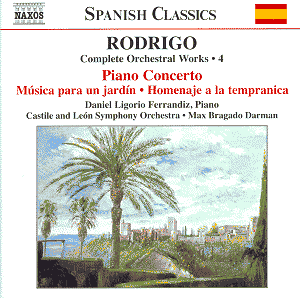It is a shame that Rodrigo is only usually known for
his guitar music. Naxos are to be congratulated on redressing the balance.
The Piano Concerto started life in 1942 as the Heroic
Concerto for piano and orchestra and I think that title should have
been retained for it sums up the piece. The pianist Joaquín Achúcarro
revised it and suggested corrections as to orchestration and the more
discreet use of repetition. This second version was first performed
in 1996 with Achúcarro. He is a formidable pianist. I first saw
him play Brahms' Piano Concerto no 2 in the Colston Hall, Bristol in
1967 and when I heard Kissin perform it at the 2002 Proms I was horrified.
That was a simply dreadful performance.
Rodrigo's concerto is heroic. It sounds like a medieval
epic transferred to the Hollywood screen. One expects a dashing Robin
Hood or El Cid to appear at any moment and I am afraid some of the music
is so Hollywoodish that it is banal. On the other hand the sounds one
has become accustomed to of 13th century pageantry as portrayed by film
composers is often very stirring. The opening movements are very bright
and cheerful if a little schmaltzy at times with braying hunting horns
and a grandeur that is not held back by pomposity. The piano writing
is virtuosic if a little clichéed.
But the music could be viewed and heard in a different
way. If you know the piano concertos by Scharwenka you will get an idea
of what to expect although Rodrigo's work does not have the structural
soundness of Scharwenka. The Spaniard's concerto sometimes declines
into episodic forms but, like the Walton Symphony no. 1, I find this
concerto to be somewhat overwhelming in its power and intensity.
Yet there is another argument and consideration. The
other famous piano and orchestra work by a Spanish composer is Falla's
Nights in the Gardens of Spain which he took seven years to write
and the results show that. Falla's work is very flabby. Rodrigo's is
not. The piano writing in the Rodrigo is stunning and very well executed.
The sound is crystal clear and it is a highly enjoyable and exciting
piece. Whether it is durable might be another matter. The Prelude on
a poem of the Alhambra owes something to the style of Falla but is redeemed
by some imaginative orchestration. It is a better piece than the concerto
although not so immediate. It recalls the music of Spain but with a
superb orchestration that avoids the clichés of clattering feet,
noisy shoes, anaemic guitars and infuriating castanets. There are some
excellent rhythmic contrasts and the sultry Spanish heat is expertly
caught in the central lento section.
Musica para un jardín is an orchestration
of Berceuses for piano of 1935 first performed under the baton
of Jose Iturbi in Valencia in 1958. The four movements correspond with
the seasons of the year. There are allusions to Spring in the opening
prelude and the conclusion. Autumn is depicted by the cor anglais and
oboe in the second movement and the horn takes it over in the winter
section. There are some wonderful sonorities here but I am not sure
the suite works as a whole. Attractive it is but few of us will enthuse
about it whereas some will about the Piano Concerto.
The next piece is the prize. Translated it means homage
to the precocious girl and is a tribute to Geronimo Gimenez's zarzuela
La Tempranica of 1900. Rodrigo wrote this while he was living
in Paris and it was originally scored for string orchestra and premiered
in Paris in the spring of 1939. It begins with an elegant prelude. This
leads into the first theme of the zarzuela followed by a dance and a
lively finale. The work was later re-scored for orchestra and premiered
in Paris in December 1939. And there is a brief use of the castanets
in an otherwise super score.
Juglars is another short essay, Rodrigo's first
orchestral piece. It is almost a mini-symphony in ABA form: the outer
sections are quick and in the tonality of A with a sad G minor slow
section in the middle. The opening snare drum style is a bit off-putting.
A charming piece all the same but, sadly, it says little.
David Wright
